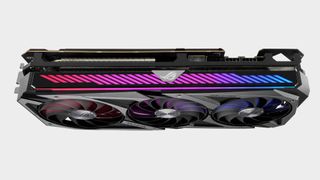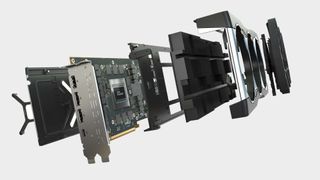AMD's DLSS alternative won't be ready to rival Nvidia until after launch
The picture of Big Navi and its ray tracing potential is becoming clearer.

AMD is working on an answer to Nvidia’s performance and image-quality boosting super sampling tech, DLSS. But it won’t be ready for the launch of the new AMD Radeon RX 6000 series graphics cards, variously known as RDNA 2 and Big Navi, later this month. Early indications of RDNA 2’s ray tracing performance have emerged and, as expected, peg AMD’s new graphics architecture in between Nvidia’s new Ampere cards and its last-gen Turing tech.
So it looks like AMD could do with some DLSS-like magic.
AMD briefly alluded to its alternative to Nvidia’s DLSS in the RX 6000 launch presentation. It labelling the potential tech as ‘Super Resolution’ and placed it in the wider FidelityFX suite of technologies, which also includes the likes of variable shading, denoising and ambient occlusion. The Verge’s Tom Warren has since discussed the feature with AMD. Although AMD isn’t ready to reveal much, we do now have a few more details.
“The company is promising its super sampling technology will be open and cross-platform, which means it could come to next-gen consoles like the Xbox Series X and PS5. AMD is working with a number of partners on this technology, and it’s expecting strong industry support. Unfortunately, this won’t be ready for the launch of these three new Radeon RX 6000 Series cards,” Warren says.
We’re confident Nvidia wouldn’t want to jump on this particular open source bandwagon, so that aspect is probably academic in terms of the battle between it and AMD. Meanwhile, major questions remain concerning AMD’s super sampling implementation.
Arguably the defining feature of Nvidia’s DLSS is its use of super computers to create reference data embedded in the graphics driver, which in turn is used by Nvidia’s AI Tensor cores to upscale rendered graphics in real time and with unprecedented quality.

DLSS is particularly relevant in the context of ray-tracing. The latter comes at a significant performance cost even on Nvidia’s latest Ampere GPUs. So, the ability DLSS brings to run at lower resolutions while upsampling to achieve the image quality of higher resolutions is a major benefit.
The biggest gaming news, reviews and hardware deals
Keep up to date with the most important stories and the best deals, as picked by the PC Gamer team.
Critically, it’s not known whether AMD’s Super Resolution technology will feature a comparable super computing effort to refine the upscaling process or if it’s purely an algorithm processed locally on the GPU.
As for RDNA 2’s ray tracing performance, benchmarks posted by twitter user @PJ_Lab_UH suggest that even without a DLSS-like super sampling technology enabled, RDNA 2 is reasonably competitive.
R5 3500x @ 4.3 + RX 6800 SOTTR RT on 4K 46 2K 80 pic.twitter.com/LpSCn6xBGNOctober 31, 2020

Best CPU for gaming: the top chips from Intel and AMD
Best graphics card: your perfect pixel-pusher awaits
Best SSD for gaming: get into the game ahead of the rest
The results (admittedly from a phone camera, so salt imbibing recommended) show the performance of the cut-down RX 6800 model and place it around five per cent behind the Nvidia GeForce RTX 3070 with DLSS enabled in Shadow of the Tomb Raider at 1440p.
At 4K, the gap is larger, growing to around 15 to 20 per cent.
The results also put the RX 6800 ahead of the 3070 when the latter is running without DLSS enabled. Of course, according to AMD’s performance numbers from the RDNA 2 launch event, the RX 6800 carries a pure rasterisation advantage over the 3070 in Shadow of the Tomb Raider.
And, when enabled, Shadow of the Tomb Raider’s ray-tracing implementation is relatively limited. So, even if these numbers are accurate, they may not be broadly indicative of how AMD’s ray-tracing performance compares with that of Nvidia.
All will be revealed here later this month when the RX 6800 and RX 6800 XT are released on November 18.

Jeremy has been writing about technology and PCs since the 90nm Netburst era (Google it!) and enjoys nothing more than a serious dissertation on the finer points of monitor input lag and overshoot followed by a forensic examination of advanced lithography. Or maybe he just likes machines that go “ping!” He also has a thing for tennis and cars.
Most Popular






